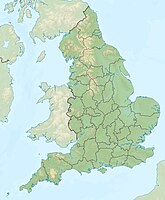Isle of Thanet
| Isle of Thanet | ||
 Historical map, the former Wantsum Channel off the island of Thanet (in the far east) at the time of arrival of the Anglo-Saxons in Britain is |
||
| Geographical location | ||
|
|
||
| Coordinates | 51 ° 22 '8 " N , 1 ° 25' 8" E | |
| Waters 1 | North Sea | |
The Isle of Thanet [ aɪ̯l ɒv ˈθænɪt ] is an area in northeast Kent in southeast England , which was formerly separated from the mainland by the Wantsum Channel . The first bridge over the canal was built in Sarre in 1485. The canal silted up from the 15th century, so that the island is only partially cut off from the mainland by the smaller rivers Wantsum and Stour . The seaside districts of Margate , Ramsgate and Broadstairs are located on Thanet, along with a number of other localities . Manstonis further away from the coast and was an important airfield of the Royal Air Force during World War II , which is now being expanded as a commercial airfield .
Due to its proximity to France and thus continental Europe , landed in 55 BC. The first Roman invaders on Thanet. They built the camp Rutupiae in a bay opposite the island and later the Regulbium fortification at the northern end of the channel . According to archaeological results from 2017, Julius Caesar could have been involved in the 2nd invasion in 54 BC. Landed in Pegwell Bay on Thanet and set up camp there.
It was Thanet that King Vortigern made available to the Anglo-Saxons under Hengest and Horsa as the first settlement area, with which the Anglo-Saxon invasion began in 449 AD. Towards the end of the 5th century, Thanet was part of the Jut Kingdom of Kent .
By Augustine of Canterbury is said that he was in Ebbsfleet landed on Thanet before he started from Canterbury to from the British Isles Christianize . The Vikings wintered twice on Thanet in the 9th century , once in 851 and then again in 864.
Administratively, the Isle of Thanet is the since 1974 Thanet district .
The burial ground
On the Isle of Thanet, archaeologists discovered an unusual burial ground at Pegwell Bay. The funeral rituals and the origin of the dead are puzzling. Complete body graves, individual bones, manipulated and worked bones of humans and animals were found. The oldest dead came from the Early Bronze Age (2200–1500 BC), then from the Iron Age, sometimes with long pauses in between. Over 2000 years later, in the late 7th century AD, the Anglo-Saxons laid their dead here.
Area No. 2018 consisted of at least 36 overlapping small pits. The people decided to lay their dead here three times: for the first time in the late Bronze Age (1100 to 800 BC) and after a 300-year break in the early and middle Iron Age (500-200 BC).
In pit No. 3666, which was dug in the Bronze Age, the archaeologists found the complete skeleton of a woman who had died at the age of about 50. Since cremation was practiced in the Bronze Age, body burials from this period are rare. The cause of death were punch marks on the back of the head that had been struck by a sharp weapon - probably a sword. There are no traces of resistance. The excavators believe that she died as a human sacrifice. The woman had a piece of chalk in her left hand. She was bedded on two lambs slaughtered immediately after birth. A C14 date showed that the lambs had been dead for at least a year when the woman was placed on them. Two more lambs lay in her lap. There were two children in the grave, a teenage girl and a grown man. His body had probably been tied up or tied in a sack for some time before reaching Pit # 3666. The children's skulls were also reburied when they were already partially decomposed. The teenager was resting on the head of a cow. There were other individual human bones in the layers of earth above the five dead. Mysteriously, they weren't more recent than one might have guessed. They came from older dead people who had been dug up again. These strange rites continued for five or six centuries after this burial, but pit # 3666 remained the most complex find.
The results of the oxygen and strontium isotope analysis of the teeth were a surprise. The dead were not all from Britain. At all times, people from Scandinavia and the western Mediterranean had come here. Some came to Britain when they were between three and twelve years of age. Overall, the teeth of 23 individuals could be examined more closely. Nine (40%) were British - five from the Late Bronze Age, four from the Iron Age. Eight (35%) were Scandinavians; probably they came from southern Norway or western Sweden. Two were from the Bronze Age and six from the Iron Age. The remaining six (25%) had come to Thanet from the western Mediterranean - four in the Bronze Age, one in the Iron Age.
Web links
Individual evidence
- ↑ Harald Frater: scinexx | Caesar's landing site discovered in England: Finds in southeast Kent could have come from the Roman emperor's fleet. Retrieved November 29, 2017 .


